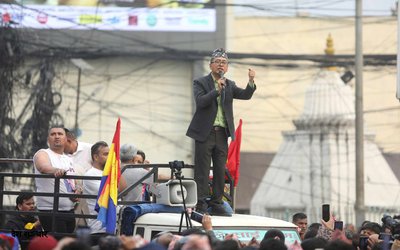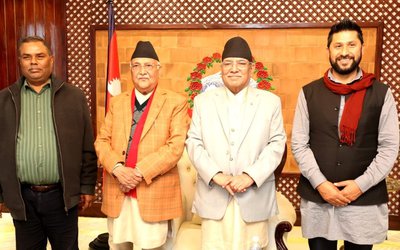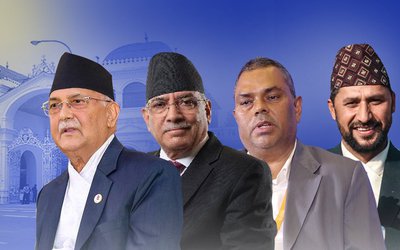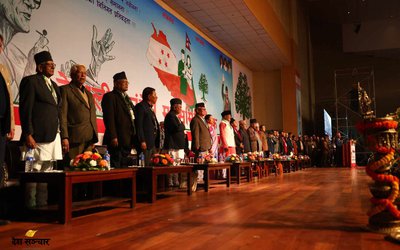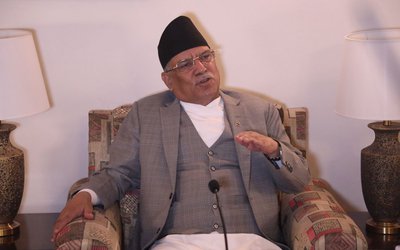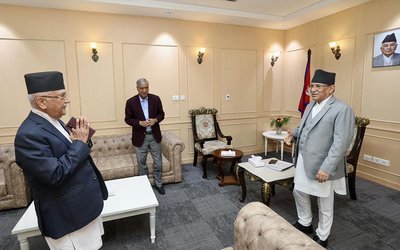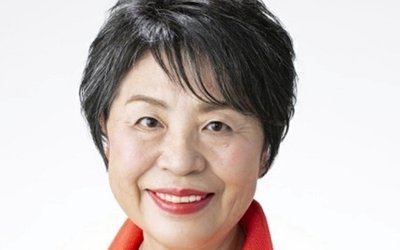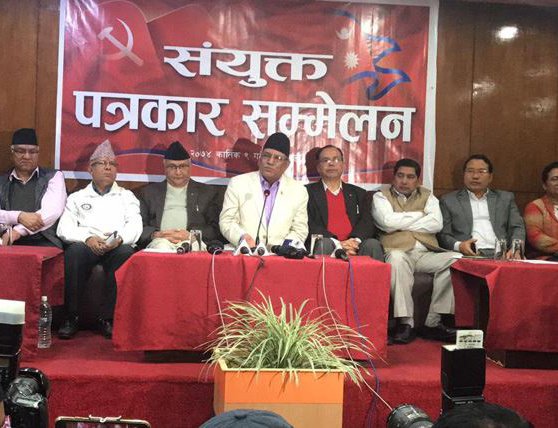
In the midst of apathy among the people, several political leaders, who are tainted by one or the other kind of scandal and corruption, cashed in on their affiliation with political parties and filed their nomination on 23rd October for the first phase of elections. As many as 807 contestants have filed their candidacy for the elections to the House of Representatives and State Assemblies to be held on November 26.
Although the political cadres and sympathizers of political parties rushed to them to back the candidacies, the common people have not shown much of an interest. Divided between the Communist Front led by CPN-UML and Maoist Centre and democratic front of Nepali Congress and other fringe parties, the people will be going to the elections, which are mandatory to renew the legality of a new political system and to complete the political transition.
Wiped from all over the world, the communist flag, with sickle and hammer, and pictures of Lenin, Marx, and Mao, is fluttering in the backyard of democratic India. Encouraged by the unity of two major communist parties, their militant cadres are so enthusiastic that they hope to sweep the election of provincial and central parliaments.
“The victory of our alliance is certain. We will chart our new socialist and communist course in the country,” thundered Pushpa Kamal Dahal, leader of Maoist Centre. “We will show the world how the unity of communist parties makes a difference.”
There is a reason behind Prachanda’s logic. If one compares the voters of the recent local level elections, the two left parties combined have an edge over Nepali Congress. Looking at the threat of rising communist power, prime minister Sher Bahadur Deuba has been making every effort to bring all non-communist forces into his fold.
“If the communist alliance wins the elections, they will impose an authoritarian system in Nepal. All the democrats need to combine forces to challenge the communist upsurge,” said Prime Minister Deuba.
However, the common people have responded to neither front, given their reported involvement in various scandals, including corruption and misuse of power. For a majority of people, the election is just a process to choose all the old faces that have been part of the political drama of the last ten years.
According to the Joint Election Operation Centre (JEOC) at the Election Commission, of the total 807 persons filing candidacies, 323 have registered their candidacy for the election to the House of Representatives and 484 for the State Assembly elections.
There will be polls in 32 mountain and Hill districts in the first phase on November 26. The first phase of the twin elections is taking place in all the provinces.
Elections in the remaining districts will be held on December 7. The country must conduct the elections of the House of Representatives and provincial assemblies by January 21 as per the constitutional deadline.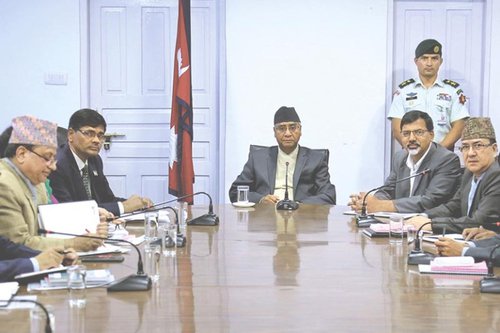
To complete the process, the election will be held for 165 electoral constituencies for the House of Representatives and 330 constituencies for the provincial assemblies.
At a time when Nepal has been passing through all the political and institutional reforms, many constitutional and legal challenges are likely to appear when the elected institutions start functioning.
Local level leaders, who were elected with promises to bring Singh Durbar (all central power and resources) to the grass root level, are yet to assert their executive, legislative and judicial authorities given by the new constitution.
As per the constitution, local levels can work in the format of a central level with the board of three branches: executive, legislature, and judiciary. Some local level councils have even passed the law to utilize the resources, challenging the central authority.
With seven provinces, 766 local units and one central body, there will be 774 institutions with executive, provincial and judicial powers delegated by the constitution. As local level institutions are exercising the constitutional power, other seven provinces will follow suit after the elections. The center will obviously do the same.
Given the vacuum of popular political leaders at the center, all the local units are likely to project themselves as leaders, intensifying the power struggle between the three tiers of government over the resources. However, as there is no individual political leader to direct the institutions, unifying the nation under a single command is a matter of worry to all. Nepal Army, which is the only remaining and the oldest legitimate institution, is capable to manage these aspects but it cannot do it alone without a strong political leadership.
“Although the monarchy is a feudal and undemocratic institution surrounded by aristocrats and feudal lords, it had unified all religious, cultural, linguistic and ethnic groups and remained a symbol of national unity of Nepal even in the absence of democratically elected popular leaders. However, even after a decade of a declaration of Nepal as a republic, political parties have failed to produce a dynamic political leader to unify the diverse society. In the context of complete social and political inclusion and complete devolution of power, we are very much worried about how this nation survives,” said a senior Kathmandu based diplomat of South Asia. “The recent political development of Catalina of Spain adds to my worries.”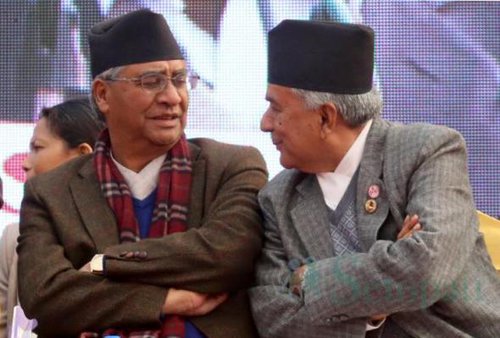
Surviving for centuries in equilibrium between two powers India and China, Nepal is likely to face multiplier effects of problems with the increasing security concerns of both the neighbors. Sharing an open border and ethnic, religious and cultural similarities, India will be more affected from any political or other disorder in Nepal.
Although a likely scenario for the future is one of turbulence, the election for provinces and national parliament will be held at the stated date of November 23 and December 6. “My concern is how the newly elected provinces and center will maintain the present power struggle and prevent any political and social disorder,” said a diplomat.
As corruption is rampant all over and institutions created to curb corruption are unable to control it, the society is in a major crisis. In a recent land scam of almost two billion rupees of Nepal Oil Corporation, the media exposed the high-level political connection and backing. All three major political parties, which remained in power and opposition, have maintained silence over the land scandal. Divided politically, the judiciary, which is completely under the nominees of political parties, is also unable to address the concern.
As political parties are selecting the candidates on the basis of their money and muscle power, there is an apathy among the people over the prospects of the election. Political parties are welcoming everyone to join them and honest and retired senior police officers and persons with several criminal records are standing in the parties side by side.
Frustrated by the overall economic situation where the top five percent of the population shares 90 percent wealth, people are losing the faith in political leadership. Although Nepal Army has still expressed its commitment to the current political process and constitution, it will be difficult for it to back the corrupt political leadership if they do not clean the process.
Corruption investigations have ensnared successive previous prime minister’s administrations in Nepal. Some are even openly pursuing military intervention as an idea for a certain period to clean the system. “Either the institutions solve the political problem through the courts, removing those elements involved in illegal acts from public life, or Army will have to impose the solution,” said a retired army officer.
Others argue that the solution of Army intervention won’t be easy. It will bring trouble as well. Only through democracy and elections, the process can be changed, not through any authoritarian intervention.
As the country is gradually heading towards disorder, with exposes of series of corruptions and scandals, former King Gyanendra, who has dethroned a decade ago, issued a public statement saying that he is ready to give the leadership to the country. “I am ready to give the leadership to the country if people want me to do so.”
Unlike in the past, there was less criticism against the former King’s statement. In social media, there are more voices of applause than condemnation. People even came out in Birgunj and Kathmandu Mandala calling on the former King to play a role.
Having lived for centuries under the monarchy, Nepali people are familiar with the monarchical system. Former King’s speech was troubling enough on its own. But political leaders seem to have lost the ground to criticise the move. No one in the civilian administration criticized the remarks either.
The former King is right about one thing: Nepal is in turmoil, economic and political. The country is just barely emerging from effects of the major earthquake. There are corruption cases becoming rampant and law and order is a problem. In broad daylight, criminals shot president of Federation of Contractors’ Association of Nepal Sharad Kumar Gauchan dead. Former lawmakers are facing their own corruption charges.
The phrase “the institutions are working,” stubbornly repeated by high officials, has become so hard to believe that on social media it now serves as an ironic refrain to highlight fresh disorder.
Given the growing incidents of corruption and criminalization of politics, Nepalis are losing their faith in democratic institutions and elections. Despite making historic progress, the conflict-era violence and related incidents are yet to be settled. The Trust and Reconciliation Commission and Disappearance Commission have more than 1000 complaints from the conflict-era incidents.
Passing from a series of turmoil, the coming elections are a major course in Nepal’s political process, which can turn out to be a disaster for the nation or, else, save the nation.

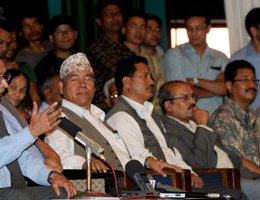

Keshab Poudel
Poudel is the editor of New Spotlight Magazine.
- IFAD/MoICS’s SMRIDDHI: Retaining Returnee Workers
- May 03, 2024
- MoICS/IFAD: SAMRIDDHI’S Leading To Apprenticeship
- May 01, 2024
- MoICS AND IFAD: SAMRIDDHI For Entrepreneur And Employment
- Apr 29, 2024
- IWMI: SoLAR Global Science-Policy Forum Conference
- Apr 25, 2024
- CLA: Samriddhi For Skill Development
- Apr 23, 2024

